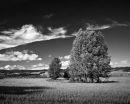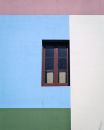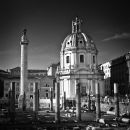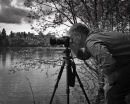Articles
Using ND-filters
04/01/2012
To make longe exposures photos, it is crucial to use ND-filters. This article describes how I do it.
ND-filter is crucial for shooting long exposures photos. The Fujifilm FinePix X100 has a built-in ND-filter “that reduces exposure by the equivalent of 3EV” (manual p. 57). This is of good help when shooting with low F-values in bright sunlight. But it will not always be sufficient to shoot long exposure shots.
To get the possibility with the Fuji X100 to prolong the exposures time further, I bought from Light Craft Workshop their Fader ND MK II. It can be rotated to get different darkness, from 2EV to 8EV. I chose a filter-diameter of 52 mm. The adapter-ring for the Fuij X100 has a diameter of 49 mm. So to fit the L.C.W. ND-filter, I also bought a step-up ring for 49 - 52 mm. I did it because at least here in Norway it is much more easy to find filter with the diameter of 52 mm than 49 mm. A good bonus with the L.C.W. filter is that it is delivered with a lens-cap in Nikon-style with clips on and fits good. With the filter on, the camera lens has a good protection.
Most of my long exposures shots are taken at beaches or shorelines to “brake” or “stop” the water movements. In the sub-gallery “Sea and Sky” under the gallery “Nature”, I have posted a series of photos taken in this way. I have different tripods, but for the lightweight Fuji X100 I have so far only the small and lightweight Manfrotto 745B. It is a very good experience to have such lightweight photo equipment with me …
When I have found a place to shoot and set up the tripod to the preferred hight, I set the self timer to 2 seconds. This is to avoid that there is some vibration in the setup after having pushed the shutter button.
To get long enough exposures f.i. while the sun is setting, I will first activate the built in ND-filter in the camera. After that normally I will choose the smallest aperture opening, F16 in the case of the Fuji X100. The ISO is set to it lowest value, in my case 200 because I shoot Raw. I think this kind of photos should always be shot in Raw and processed afterwards in LightRoom or similar programs. It makes it easier to get full control over the colors, light etc.
Then I set the focus to the longest distance if I only want the horizon in focus. I set the speed-dial to “T” and I normally will use the LCD to control the light of the photo, but of course the VF will also do. The camera meters through the filter and the lens, so I check the EV-scale on the left side. I rotate the L.C.W. filter to a setting on its scale to choose the darkness and then I rotate the jog-dial on the camera to find a time setting that pushes the EV-scale metering up towards 0. The EV-scale starts quite negative. The reading can be anything from1 second and more, depending on the darkness. Then I shoot … not bothering if the LCD shows it right or not. The exposed photo will be right …
The time will depend on how much or less movement one wants the water to show. This is even more so when shooting rivers, streams or waterfalls. Normally I will shoot a series with different darkness and time to get multiple versions. Depending on the mood, light etc., I will choose pictures with shorter or longer settings.
Mostly I have used ND-filter on the Sigma DSLRs. When I bought them, I did not know the L.C.W. fader filters, so I have fixed filters from ProZigma, one ND4 and two ND8 to have the possibility to add more darkness if I need to. Because of the different diameters of the lenses and the expenses, I bought the filter with a diameter of 82 mm and step-down rings 82 - 77 mm, 77 - 72 mm, 72 - 62 mm. It makes it look quite strange, but it works without problems and because the filter is wider than the lens openings, I don’t have problems with vignetting. It is important though that the filters are made of glass. I tried first some with plastic, but they tend to shift the colors when more are added.
The idea behind this technique is that with the camera it is possible to give an impression of the nature that the human eye can not grasp. F.i. instead of fixing moving water and stationary clouds in a normal exposure, this kind of photography can transmit an impression of stationary water and moving clouds. Depending on the light the water can turn to be a mirror.
To shoot landscapes in this way, can turn it to art, where the light, the clouds and the movement of the water can be seen as Gods gift to the artist.
1st version, revised 12th of January 2012
To get the possibility with the Fuji X100 to prolong the exposures time further, I bought from Light Craft Workshop their Fader ND MK II. It can be rotated to get different darkness, from 2EV to 8EV. I chose a filter-diameter of 52 mm. The adapter-ring for the Fuij X100 has a diameter of 49 mm. So to fit the L.C.W. ND-filter, I also bought a step-up ring for 49 - 52 mm. I did it because at least here in Norway it is much more easy to find filter with the diameter of 52 mm than 49 mm. A good bonus with the L.C.W. filter is that it is delivered with a lens-cap in Nikon-style with clips on and fits good. With the filter on, the camera lens has a good protection.
Most of my long exposures shots are taken at beaches or shorelines to “brake” or “stop” the water movements. In the sub-gallery “Sea and Sky” under the gallery “Nature”, I have posted a series of photos taken in this way. I have different tripods, but for the lightweight Fuji X100 I have so far only the small and lightweight Manfrotto 745B. It is a very good experience to have such lightweight photo equipment with me …
When I have found a place to shoot and set up the tripod to the preferred hight, I set the self timer to 2 seconds. This is to avoid that there is some vibration in the setup after having pushed the shutter button.
To get long enough exposures f.i. while the sun is setting, I will first activate the built in ND-filter in the camera. After that normally I will choose the smallest aperture opening, F16 in the case of the Fuji X100. The ISO is set to it lowest value, in my case 200 because I shoot Raw. I think this kind of photos should always be shot in Raw and processed afterwards in LightRoom or similar programs. It makes it easier to get full control over the colors, light etc.
Then I set the focus to the longest distance if I only want the horizon in focus. I set the speed-dial to “T” and I normally will use the LCD to control the light of the photo, but of course the VF will also do. The camera meters through the filter and the lens, so I check the EV-scale on the left side. I rotate the L.C.W. filter to a setting on its scale to choose the darkness and then I rotate the jog-dial on the camera to find a time setting that pushes the EV-scale metering up towards 0. The EV-scale starts quite negative. The reading can be anything from1 second and more, depending on the darkness. Then I shoot … not bothering if the LCD shows it right or not. The exposed photo will be right …
The time will depend on how much or less movement one wants the water to show. This is even more so when shooting rivers, streams or waterfalls. Normally I will shoot a series with different darkness and time to get multiple versions. Depending on the mood, light etc., I will choose pictures with shorter or longer settings.
Mostly I have used ND-filter on the Sigma DSLRs. When I bought them, I did not know the L.C.W. fader filters, so I have fixed filters from ProZigma, one ND4 and two ND8 to have the possibility to add more darkness if I need to. Because of the different diameters of the lenses and the expenses, I bought the filter with a diameter of 82 mm and step-down rings 82 - 77 mm, 77 - 72 mm, 72 - 62 mm. It makes it look quite strange, but it works without problems and because the filter is wider than the lens openings, I don’t have problems with vignetting. It is important though that the filters are made of glass. I tried first some with plastic, but they tend to shift the colors when more are added.
The idea behind this technique is that with the camera it is possible to give an impression of the nature that the human eye can not grasp. F.i. instead of fixing moving water and stationary clouds in a normal exposure, this kind of photography can transmit an impression of stationary water and moving clouds. Depending on the light the water can turn to be a mirror.
To shoot landscapes in this way, can turn it to art, where the light, the clouds and the movement of the water can be seen as Gods gift to the artist.
1st version, revised 12th of January 2012










